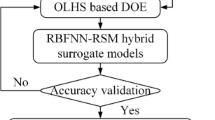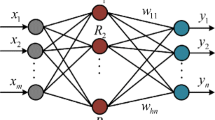Abstract
To achieve lightweight of automobile body side structure, a body optimization framework is established. The optimization framework includes numerical simulation, wall thickness, and material set parameterization, design of experiment, surrogate model, NSGA-II, and multi-criteria decision making (MCDM). The finite element model of automobile body side collision is established, and the accuracy of the model is verified by side collision experiment. The problem that it is difficult to embed discrete material variables into the optimization model is solved by using material set parameterization technology. The RBF surrogate model and NSGA-II are applied to the multi-objective lightweight optimization of the body side structure. A hybrid weight & GRA decision method is proposed for Pareto front data mining. Compared with other MCDM methods, the decision results using hybrid weight & GRA are more robust and reasonable. Through the integrated optimization of the wall thickness, material, and performance of the body side structure and the Pareto front data mining, the mass of the body side structure is reduced by 9.21 kg, the lightweight rate is up to 15.93%, and the crashworthiness performance indicators meet the design baseline requirements.














Similar content being viewed by others
References
Barut E, Eker AA, Yöntem O (2024) Effects of different design and lightweight material on energy distribution and collision characteristics for hot-formed B-pillar using finite element simulation. Proc Inst Mech Eng Part D-J Autom Eng. https://doi.org/10.1177/0954407023122583
Chen PY (2019) Effects of normalization on the entropy-based TOPSIS method. Expert Syst Appl 136:33–41
Chen JF, Hsieh HN, Do QH (2015a) Evaluating teaching performance based on fuzzy AHP and comprehensive evaluation approach. Appl Soft Comput 28:100–108
Chen SM, Wang DF, Shi TZ, Chen J (2015b) Multi-objective optimization of vehicle sound package in middle frequency using gray relational analysis coupled with principal component analysis. Fluctuation Noise Lett 14:27
Chen, H., LU, C. H., Feng, L., Liu, Z., Sun, Y. & Chen, W. 2023. Structural optimization design of BIW using NSGA-III and entropy weighted TOPSIS methods. Advances in Mechanical Engineering, 15, 13.
Deb K, Pratap A, Agarwal S, Meyarivan T (2002) A fast and elitist multiobjective genetic algorithm: NSGA-II. IEEE Trans Evol Comput 6:182–197
Ding Y, Yuan Z Z, Li Y H (2008) Performance Evaluation Model For Transportation Corridor Based On Fuzzy-AHP Approach. In: 5th International Conference on Fuzzy Systems and Knowledge Discovery, Oct 18–20 2008 **an, PEOPLES R CHINA. LOS ALAMITOS: Ieee Computer Soc, 608–612.
Du XJ, Liang HX (2023) Lightweight design of automotive front rail based on topology optimisation and collision analysis. Int J Crashworthiness. https://doi.org/10.1080/13588265.2023.2253036
Evgeniou T, Pontil M, Poggio T (2000) Regularization networks and support vector machines. Adv Comput Math 13:1–50
Gao DW, Liang HT, Shi GJ, Cao LQ (2019) Multiobjective optimization of carbon fiber-reinforced plastic composite bumper based on adaptive genetic algorithm. Math Probl Eng 2019:12
Huang WC, Shuai B, Sun Y, Wang Y, Antwi E (2018) Using entropy-TOPSIS method to evaluate urban rail transit system operation performance: the China case. Trans Res Part a-Policy Pract 111:292–303
Ilo S, Just C, Xhiku F (2012) Optimisation of multiple quality characteristics of hardfacing using grey-based Taguchi method. Mater Des 33:459–468
Lai XN, Pang Y, Zhang S, Sun W, Song XG (2022) An adaptive ensemble of surrogate models based on heuristic model screening. Struct Multidisc Optim 65:21
Li XN, Zhao ZH (2020) Location layout design of aircraft parts assembly based on MSVR. Chin J Aeronaut 33:1532–1540
Li S, Bai JT, Wang XC, Song LM, Luo K, Zuo WJ (2020) Equivalent substitution criteria of aluminum for steel and its application in automobile structures. Adv Mech Eng 12:17
Li SH, Wang DF, Wang S, Zhou CH (2023) Structure-connection-performance integration lightweight optimisation design of multi-material automotive body skeleton. Struct Multidisc Optim 66:23
Lu RH, Gao WZ, Hu XL, Liu WH, Li YW, Liu XH (2018) Crushing analysis and crashworthiness optimization of tailor rolled tubes with variation of thickness and material properties. Int J Mech Sci 136:67–84
Masoumi Z, van Genderen J, Niaraki AS (2021) An improved ant colony optimization-based algorithm for user-centric multi-objective path planning for ubiquitous environments. Geocarto Int 36:137–154
Pyrz M, Krzywoblocki M (2019) Crashworthiness optimization of front rail structure using macro element method and evolutionary algorithm. Struct Multidisc Optim 60:711–726
Rahim AAA, Musa SN, Ramesh S, Lim MK (2020) A systematic review on material selection methods. Proc Inst Mech Eng Part L-J Mater Design Appl 234:1032–1059
Sengupta D, Das A, Bera UK, Chen L (2023) A sustainable green reverse logistics plan for plastic solid waste management using TOPSIS method. Environ Sci Pollut Res 30:97734–97753
Shi DY, Watanabe K, Naito J, Funada K, Yasui K (2022) Design optimization and application of hot-stamped B pillar with local patchwork blanks. Thin-Walled Struct 170:16
Simpson TW, Peplinski JD, Koch PN, Allen JK (2001) Metamodels for computer-based engineering design: survey and recommendations. Eng Comput 17:129–150
Simsek B, Iç YT, Simsek EH (2013) A TOPSIS-based Taguchi optimization to determine optimal mixture proportions of the high strength self-compacting concrete. Chemom Intell Lab Syst 125:18–32
Soares J C F, Tereso A P & Sousa S D T (2018) Use of analytic hierarchy process (AHP) to support the decision-making about destination of a batch of defective products with alternatives of rework and discard. In: 18th Congress of the Portuguese-Association-of-Operational-Research (APDIO), Jun 28-30 2017 Valenca. New York: Springer, 365–391
Teixeira R, Nogal M, O’Connor A (2021) Adaptive approaches in metamodel-based reliability analysis: a review. Struct Saf 89:18
Trelea IC (2003) The particle swarm optimization algorithm: convergence analysis and parameter selection. Inf Process Lett 85:317–325
Ullah R, Zhou DQ, Zhou P, Hussain M, Sohail MA (2013) An approach for space launch vehicle conceptual design and multi-attribute evaluation. Aerosp Sci Technol 25:65–74
Viana FAC, Haftka RT, Steffen V (2009) Multiple surrogates: how cross-validation errors can help us to obtain the best predictor. Struct Multidisc Optim 39:439–457
Wang DF, Cai KF (2018) Multi-objective crashworthiness optimization of vehicle body using particle swarm algorithm coupled with bacterial foraging algorithm. Proc Inst Mech Eng Part D-J Autom Eng 232:1003–1018
Wang DF, Li SH (2022a) Lightweight design of a body-in-white structure using a hybrid optimisation approach. Int J Veh Des 88:121–147
Wang DF, Li SH (2022b) Material selection decision-making method for multi-material lightweight automotive body driven by performance. Proc Inst Mech Eng Part L-J Mater-Des Appl 236:730–746
Wang S, Wang DF (2021) Crashworthiness-based multi-objective integrated optimization of electric vehicle chassis frame. Arch Civil Mech Eng 21:18
Wang DF, Xu WC (2020) Fatigue failure analysis and multi-objective optimisation for the hybrid (bolted/bonded) connection of magnesium-aluminium alloy assembled wheel. Eng Fail Anal 112:17
Wang T, Li Z, Wang LM, Hulbert GM (2020) Crashworthiness analysis and collaborative optimization design for a novel crash-box with re-entrant auxetic core. Struct Multidisc Optim 62:2167–2179
**ong F, Zou XH, Zhang ZG, Shi XH (2020) A systematic approach for multi-objective lightweight and stiffness optimization of a car body. Struct Multidisc Optim 62:3229–3248
Yan C, Shen XL, Guo FS, Zhao SQ, Zhang LZ (2019) A novel model modification method for support vector regression based on radial basis functions. Struct Multidiscip Optim 60:983–997
Yeshanew ES, Ahmed GMS, Sinha DK, Badruddin IA, Kamangar S, Alarifi IM, Hadidi HM (2023) Experimental investigation and crashworthiness analysis of 3D printed carbon PA automobile bumper to improve energy absorption by using LS-DYNA. Adv Mech Eng 15:23
Yi JH, **ng LN, Wang GG, Dong JY, Vasilakos AV, Alavi AH, Wang L (2020) Behavior of crossover operators in NSGA-III for large-scale optimization problems. Inf Sci 509:470–487
You XX, Zhang MY, Niu ZW (2022) A dynamic adaptive hybrid surrogate-assisted particle swarm optimization algorithm for complex system design optimization. Eng Comput 39:2505–2531
Zhang Y, Lai XM, Zhu P, Wang WR (2006) Lightweight design of automobile component using high strength steel based on dent resistance. Mater Des 27:64–68
Zhang JF, Wang LM, Wang T, Sun HM, Zou XJ, Yuan LK (2023) Frontal crashworthiness optimization for a light-duty vehicle based on a multi-objective reliability method. Int J Crashworthiness 28:449–461
Zhou CC, Zhang HL, Chang Q, Song XK, Li C (2022) An adaptive ensemble of surrogate models based on hybrid measure for reliability analysis. Struct Multidisc Optim 65:18
Zou SC, Dai SJ, Zhao WZ, Wang CY, Zhang H (2020) Multi-objective crashworthiness optimization of vehicle body with negative Poisson’s ratio structure based on factorial analysis. Proc Inst Mech Eng Part D-J Autom Eng 234:3329–3346
Acknowledgements
This work was supported by the Research Fund of Changzhou University [ZMF23020188].
Author information
Authors and Affiliations
Contributions
All authors contributed to the study conception and design. Methodology, material preparation, numerical simulation, data collection and analysis were performed by Shenhua Li. The first draft of the manuscript was written by Shenhua Li. Software, writing-review and editing were performed by Dashuang Zhou. Anxia Pan commented on previous versions of the manuscript.
Corresponding author
Ethics declarations
Competing interests
The authors declare that they have no known competing financial interests or personal relationships that could have appeared to influence the work reported in this paper.
Replication of results
The methodology, supplementary materials, references, and parameters provided in this paper constitute all necessary information required to replicate the generated results.
Additional information
Responsible editor Zhen (Jeff) Luo
Publisher's Note
Springer Nature remains neutral with regard to jurisdictional claims in published maps and institutional affiliations.
Supplementary Information
Below is the link to the electronic supplementary material.
Rights and permissions
Springer Nature or its licensor (e.g. a society or other partner) holds exclusive rights to this article under a publishing agreement with the author(s) or other rightsholder(s); author self-archiving of the accepted manuscript version of this article is solely governed by the terms of such publishing agreement and applicable law.
About this article
Cite this article
Li, S., Zhou, D. & Pan, A. Integrated lightweight optimization design of wall thickness, material, and performance of automobile body side structure. Struct Multidisc Optim 67, 95 (2024). https://doi.org/10.1007/s00158-024-03810-1
Received:
Revised:
Accepted:
Published:
DOI: https://doi.org/10.1007/s00158-024-03810-1




